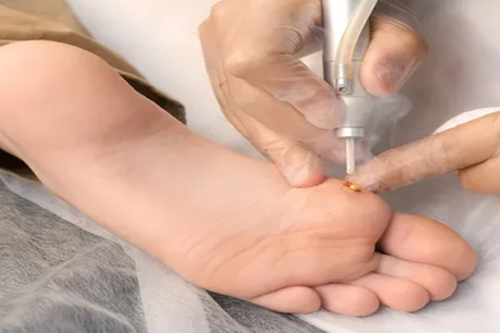
Wart Removal by Laser Treatment In Nagpur is a medical or cosmetic procedure aim at eliminating warts, which are non-cancerous skin growths cause by the human papillomavirus (HPV). Warts can appear on various parts of the body and may have different appearances depending on their location and type. Common types of warts include common warts, plantar warts (on the soles of the feet), flat warts, and genital warts.
Consulting with a healthcare professional, typically a dermatologist, can help determine the most appropriate method for wart removal base on the type of wart, its location, and individual health considerations.
Why Choose Laser Wart Removal in Nagpur?
Precision and Accuracy: Thus, Laser treatment offers unparalleled precision, allowing our experienced dermatologist. therefore, the target warts with accuracy, minimizing damage to surrounding healthy tissue.
Immediate Results: Firstly, Witness visible results during the procedure itself. Thus, Laser treatment often provides immediate improvement, reducing the size or eliminating warts in a single session.
Minimize Discomfort: Thus, To enhance your comfort, a local anesthetic or numbing cream is applied before the procedure, ensuring a relatively pain-free experience.
Safe and Controlle Process: Our dermatologists use FDA-approve laser technology, ensuring a safe and controlle process for wart removal. The focuse laser beam selectively targets the wart, breaking down its blood supply and tissue.
Customize Treatment Plans: Thus, We understand that each individual and each wart is unique. Once, Our dermatologists tailor treatment plans to your specific needs, considering the type, size, and location of the warts.
Minimal Downtime: Firstly, Laser wart removal typically involves minimal downtime. Thus, After the procedure, you can resume your daily activities with little to no disruption.
Expert Care in Nagpur: Benefit from the expertise of our skill dermatologists who have a proven track record in delivering successful wart removal outcomes using laser technology.
Common Methods Use for Wart Removal
Topical Treatments:
- Thus, Over-the-counter or prescription topical treatments containing salicylic acid. therefore, may be apply directly to the wart. These treatments work by breaking down the skin cells of the wart, allowing it to slough off over time. It’s important to follow the instructions carefully.
Cryotherapy:
- Cryotherapy involves freezing the wart using liquid nitrogen. Thus, The freezing causes the wart to die, and over time, the treat tissue may fall off.Once, Cryotherapy is a common method use by healthcare professionals.
Electrosurgery:
- Electrosurgery involves using an electrical current to cut or burn the wart. Firstly, This method is often use for larger or stubborn warts.
Laser Therapy:
- Laser treatment uses focus laser light to destroy the blood vessels feeding the wart. Thus, The wart then eventually falls off as the blood supply is disrupt.
Excision:
- Surgical excision involves physically cutting out the wart. Once, This method is typically reserve for large or stubborn warts and is performe by a healthcare professional.
Cantharidin Treatment:
- Cantharidin is a substance derive from blister beetles. It is applied to the wart, causing a blister to form beneath it. After a few hours, the blister, along with the wart, can be removed.
Immunotherapy:
- Immunotherapy involves stimulating the immune system to recognize and attack the wart. This may be done using substances such as imiquimod.
Wart Removal by Laser Treatment
Topical Treatments:
- Over-the-counter or prescription topical treatments containing salicylic acid may be apply directly to the wart. These treatments work by breaking down the skin cells of the wart, allowing it to slough off over time. Thus,It’s important to follow the instructions carefully.
Cryotherapy:
- Cryotherapy involves freezing the wart using liquid nitrogen. The freezing causes the wart to die, and over time, the treat tissue may fall off. Cryotherapy is a common method use by healthcare professionals.
Electrosurgery:
- Electrosurgery involves using an electrical current to cut or burn the wart. This method is often use for larger or stubborn warts.
Laser Therapy:
- Laser treatment uses focuse laser light to destroy the blood vessels feeding the wart. The wart then eventually falls off as the blood supply is disrupte.
Excision:
- Surgical excision involves physically cutting out the wart. Thus This method is typically reserve for large or stubborn warts and is performe by a healthcare professional.
Cantharidin Treatment:
- Cantharidin is a substance derive from blister beetles. It is applied to the wart, causing a blister to form beneath it. After a few hours, the blister, along with the wart, can be remove.
Immunotherapy:
- Immunotherapy involves stimulating the immune system to recognize and attack the wart. This may be done using substances such as imiquimod.
